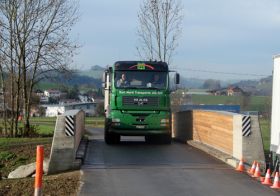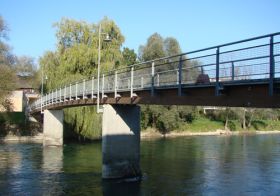Structural Dynamics
The current research in structural dynamics is focused on improving the knowledge about all aspects of braking forces on road bridges and on reducing the uncertainties regarding the prediction of the dynamic properties of structures.
While in modern structural codes most design forces acting on bridges are based on a probabilistic evaluation targeting a reference return period, braking forces are still relying on ad hoc deterministic models that consider a simplified characterization of the braking process. By developing stochastic models for estimating braking forces, performing tests with braking vehicles on bridges, and recording data with instrumented vehicles we expect to provide reliable background knowledge for formulating realistic force models.
Natural frequencies and structural damping are key parameter for the vibration serviceability assessment. While natural frequencies are computed with models, structural damping is estimated using empirical values. These estimations are notoriously affected by a high uncertainty that is mainly induced by non-structural bridge components. The goal of this research area is to improve the estimation accuracy by considering non-structural components in the models.
Braking forces on road bridges

The goal of the project is to develop a probabilistic model for estimating braking forces on road bridges. The model relied on traffic data recorded by automatic traffic counting and weight-in-motion stations and data of naturalistic driving studies with instrumented vehicles. It uses Monte Carlo simulations for constructing the tail of the distribution function of braking forces. The model allowed to investigate the impact of parameters such as bridge length, natural frequency of the longitudinal mode, damping, traffic composition, return period etc. on braking forces. The results differ significantly from past and current code models for design and assessment of road bridges.
Founding agency: Federal Roads Office FEDRO
Validation of the model for the computation of the dynamic action of the braking force on road bridges

The goals of the project are to achieve for the first time experimental results concerning the dynamic performance of bridges with floating articulation subjected to braking forces, to evaluate the effects of the nonlinear behaviour of elastomeric bearings on the dynamic performance, and to establish the prerequisites and limits of the applicability of the linear single degree of freedom model for predicting the dynamic component of the characteristic value of the braking force. The project results should enable to improve the experimental evidence of the stochastic model for computing the characteristic value of the braking forces acting on bridges.
Founding agency: Federal Roads Office FEDRO
Natural frequency and structural damping of footbridges

The deck of footbridges is often protected with a mastic asphalt pavement against mechanical abrasion and humidity. Measurements on timber and steel bridges with asphalt pavement demonstrate that they are subjected to significant changes of natural frequencies and damping ratios, and that these changes are correlated to temperature changes of the pavement. A viscoelastic model of the asphalt pavement is able to describe the observed changes of natural frequency and structural damping and the results agree well with the measurements. An eccentric location of the pavement and a strong bond between structure and pavement has a high impact.
Founding agency: Fonds zur Förderung der Wald- und Holzforschung, Federal Roads Office FEDRO

-
Share
